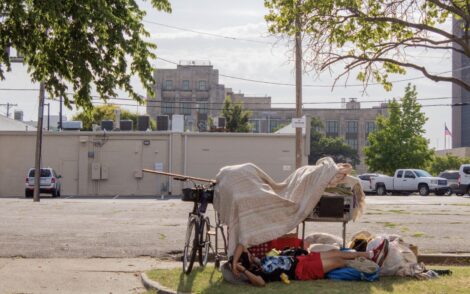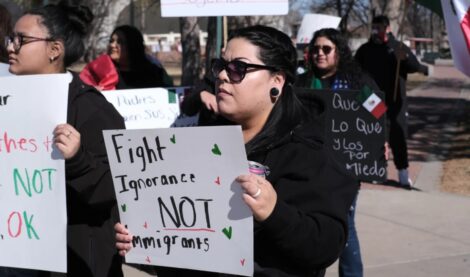Trump’s order on homelessness will undo decades of progress, Kansas service providers warn

photo by: Lily O'Shea Becker/Kansas Reflector
A man lies under shading on July 19, 2022, on North Topeka Avenue in Wichita. Service providers say an executive order by President Donald Trump could jeopardize their efforts to help those who are experiencing homelessness.
TOPEKA — Christine English-Baird spends at least one day a week distributing basic supplies to homeless people in Wichita, home to one of Kansas’ largest homeless populations.
“I do that because I can’t even fathom anybody else going through what I did,” English-Baird said. “Feeling invisible. Feeling alone.”
But English-Baird, who was homeless in Colorado and housing insecure in Kansas, says the services that once helped her could be jeopardized by President Donald Trump’s July 24 executive order, which encourages involuntary institutionalization for people in mental health crises and increased criminal pressure on people experiencing homelessness across the United States.
The order makes hefty promises of “fighting vagrancy,” “ending support for ‘housing first’ policies” and “encouraging civil commitment.” Trump followed the July order with another that deployed National Guard troops to police District of Columbia streets, targeting “drugged-out maniacs and homeless people,” he said in an Aug. 11 news conference.
The Trump administration’s approach to homelessness has sparked concern among social service providers, experts and advocates, who say the order is unspooling decades of progress.
They are skeptical that the order’s provisions will be within reach, especially as cuts to Medicaid and the U.S. Department of Housing and Urban Development are imminent. Plus, institutionalization and criminalization are some of the most expensive and ineffective ways to address homelessness, said Steve Berg, chief policy officer with the National Alliance to End Homelessness.
The threat of being taken into custody “sets people against each other,” Berg said.
“I know one thing really is true about places that have made progress on homelessness is that people are working together,” he said. “And if people are at each other’s throats over things like this, then there’s going to be more homelessness.”
Kansas Senate President Ty Masterson, an Andover Republican who is seeking his party’s nomination for governor, said Trump followed through “on his promise to restore law and order in our Kansas communities.”
“State legislation should focus on mental health and addiction treatment, reducing encampments, and keeping Kansans safe,” he said in a statement. “I’m committed to working with the White House in any way I can to deliver on the President’s agenda.”
Moving backward
English-Baird’s life was a series of revolving doors, beginning with fleeing a violent partner in Denver. She slept in a domestic violence shelter, a transitional shelter, an apartment paid for by her ex, then a rental, a bus stop, sometimes a jail cell and then the streets for three-and-a-half years. At times, she nearly died, she said.
She lost a lot along the way: apartments, her son, sometimes hope.
But English-Baird connected with a friend in Kansas who put her up so she could recover from substance use, build savings and regain hope.
With a lifetime restraining order against her ex and a new life with her husband and son, she now works to influence policies and practices for how homeless people are treated in Kansas through her role on a statewide board and through street outreach.
“Nobody wants to see anybody homeless, regardless of what that means,” English-Baird said.
To her, it means providing people safe, affordable housing, support, a sense of belonging and purpose.
To the Trump administration, it means something else entirely.
During the first Trump administration, there wasn’t much attention on homelessness, Berg said, until the end of Trump’s term, when elected officials began promoting the idea of putting homeless people in camps.
Since then, Berg said, “there’s been a desire to lock people up, I think. There’s no polite way of saying it.”
The executive order takes a four-pronged approach with the stated goal of “protecting public safety.” It cites the most recent national data that estimates how many people were experiencing homelessness on a given night last year in the U.S. — nearly 771,500 people, 274,000 of whom were unsheltered. In Kansas, almost 2,800 people experienced homelessness, which is one of the lowest state totals in the country but is also considered by service providers to be an undercount.
The order directs the U.S. Attorney General to broaden the criteria that governments use to involuntarily commit people, which currently are based on whether people pose an imminent risk to themselves or others. It also asks federal agencies to give funding preference to governments that “enforce prohibitions on open illicit drug use, urban camping and loitering, and urban squatting, and track the location of sex offenders.”
It directs funding to be allocated to “ensure individuals camping on streets and causing public disorder and that are suffering from serious mental illness or addiction are moved into treatment centers, assisted outpatient treatment, or other facilities.” It also deprioritizes housing-first programs, which get people into safe, affordable housing, often in tandem with supportive services.
Donald Whitehead Jr., executive director of the National Coalition for the Homeless, said in a July 24 statement that the executive orders take a punitive approach, which “has consistently failed to resolve homelessness” while exacerbating the challenges faced by people experiencing homelessness, substance use disorders or mental health issues.
“Everyone deserves a safe place to live,” Whitehead said. “These executive orders ignore decades of evidence-based housing and support services in practice.”
Where will people go?
The salient question, according to Randy Callstrom, the CEO of Wyandot Behavioral Health Network in Kansas City, Kansas, is where will people go?
In Kansas, he said, there is no place for people to turn.
“Even if you move people from one part of a community, they will go somewhere else,” he said.
He added: “Unless those individuals are moving into housing, they’re still going to be living in the community unhoused.”
Much depends on how the executive order is actually carried out, he said. Regardless, he said, the order significantly modifies people’s civil liberties.
And he predicts homelessness will get worse. The order moves “things back 35-40 years or longer,” Callstrom said, “and that’s concerning.”
He worries that if the order is enforced, mental health will be stigmatized and local governments, service organizations, hospitals, jails and law enforcement will be strained.
The order misses the mark when it comes to effectively serving people experiencing homelessness, Callstrom said.
“(A) longtime misperception around people who are homeless is that it is a moral failure,” he said, “that these are individuals who are less than, that we just want to push them out of line of sight and wish the problem will go away, when the reality is, you know, in many, many cases, the people who end up living unhoused have experienced many traumas in their life.”
He leads a community mental health center, which he said doesn’t have enough resources to fulfill the order’s demands. At the only public psychiatric hospital in eastern Kansas, Osawatomie State Hospital, a waitlist of 30 to 50 people has remained constant for the past decade, he said. A publicly available report indicated the waitlist was at 37 people in early August.
Kansas must build new facilities or convince current facilities to take on more people, Callstrom said.
Kansas has budgeted for roughly 710 beds in public psychiatric facilities, said Cara Sloan-Ramos, a spokeswoman for the Kansas Department for Aging and Disability Services. More than 660 of them are occupied, according to data from the department. More than 2,500 adults and more than 1,500 children use services at private psychiatric institutions.
According to a publicly available database containing regular updates of bed availability at public and private psychiatric facilities across the region, no beds were available at state hospitals.
‘Failed programs’ earn trust
In the order, the White House argues federal and state governments “have spent tens of billions of dollars on failed programs that address homelessness but not its root causes, leaving other citizens vulnerable to public safety threats.”
Agencies at all levels of government across the United States have implemented housing-first policies. Once people are housed, supportive services address their mental health, substance use, employment, familial connections and other reintegration efforts.
The order mimics the anti-housing-first efforts of the Cicero Institute, a Texas-based conservative think tank, which has pushed states for years to ban homelessness. Kansas Republicans in 2023 entertained the group’s proposal at a legislative hearing, where a Cicero Institute fellow was the only proponent.
English-Baird said she is “a firm believer” in housing first. She has seen it work on both sides — as someone in need of housing and as someone offering aid and crafting policy on a board for the Kansas Statewide Homeless Coalition. When implemented correctly, she said, the approach gains people’s trust.
“Without a stable environment, you can’t address mental health. You can’t address addiction,” she said.
Eliminating funding for organizations, especially rural ones, “literally takes away all the progress we’re making,” English-Baird said. Forcing people to be institutionalized, as the order encourages, “doesn’t do anything to get people housed,” she said.
Institutional beds are scarce, anyway, she added.
The order also bars grant funding from being used for harm reduction efforts, such as safe injection sites.
Harm reduction focuses on reducing the adverse outcomes of drug use, which can include distributing naloxone, sterile syringes and fentanyl test kits, along with first aid, treatment resources and educational materials on overdose prevention.
Harm reduction offers people supplies to stay alive and as disease-free as possible, said English-Baird, who experienced substance use and addiction. She now offers mutual aid to people experiencing homelessness in the Wichita area. Harm reduction is key, she said, to expanding treatment options and connecting people to needed mental health services.
“But we can’t do that if they’re dead,” she said.
In Kansas, illicit drug possession and distribution carry criminal penalties, as does use or possession of drug paraphernalia. Cities across the state have passed ordinances to restrict unauthorized camping on public or private land, including Lawrence, Leavenworth, Topeka and Wichita. Some also regulate panhandling and loitering.
Berg, with the National Alliance to End Homelessness, said he also thinks the order will result in more people experiencing homelessness.
If “the states that want to do the cost-effective solutions to homelessness can’t get the money to do it because they’re not punitive enough, then that’s going to mean more homelessness,” he said.
— Anna Kaminski reports for Kansas Reflector.




